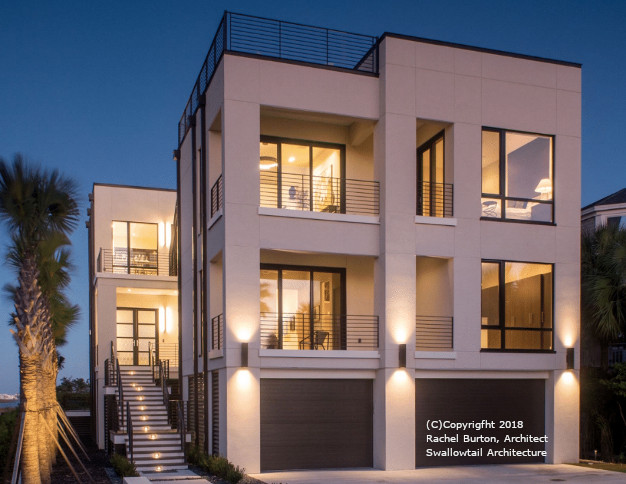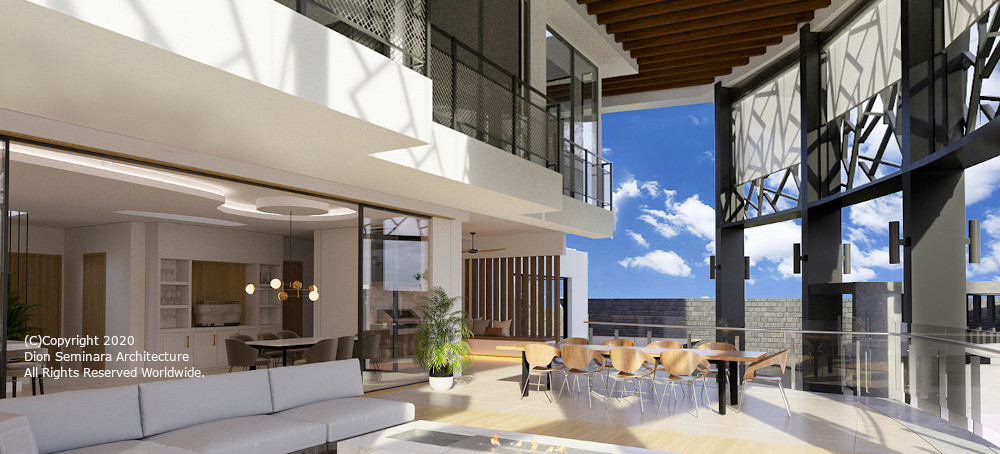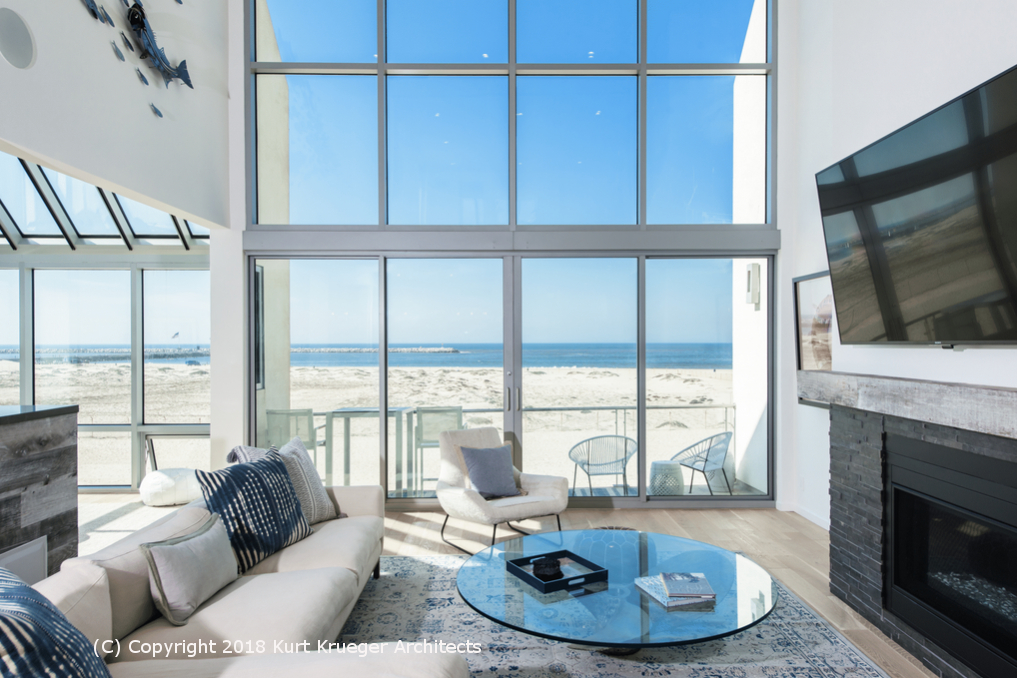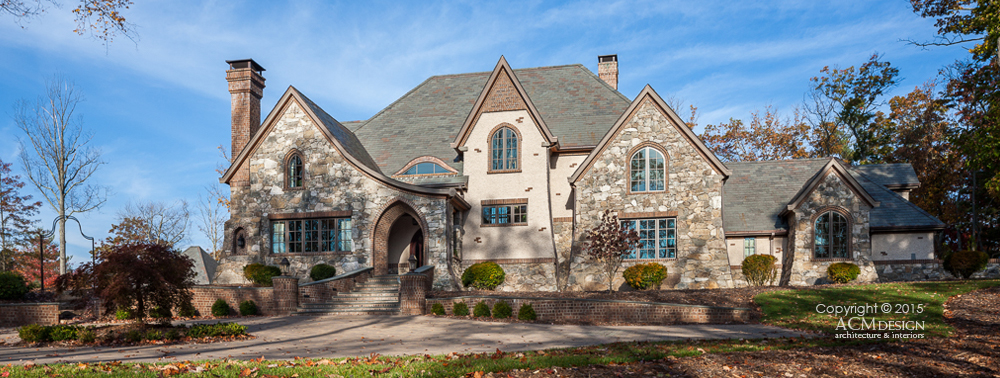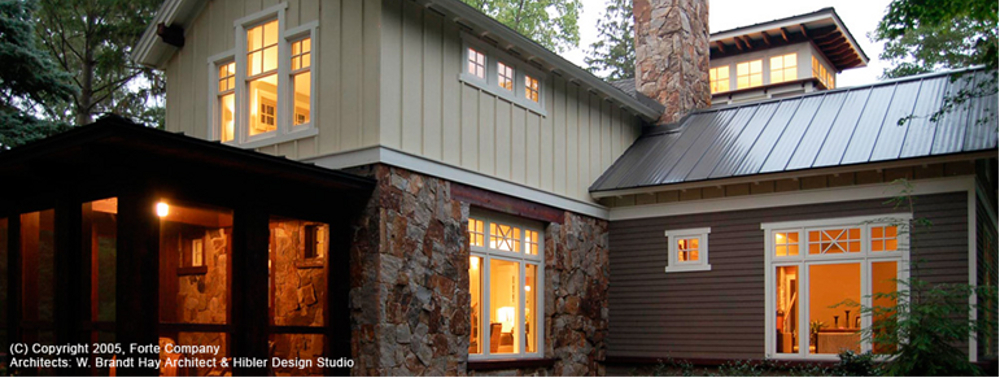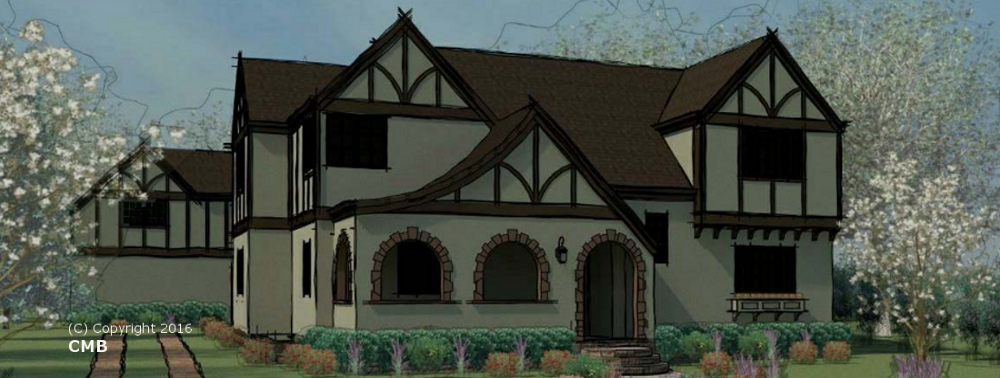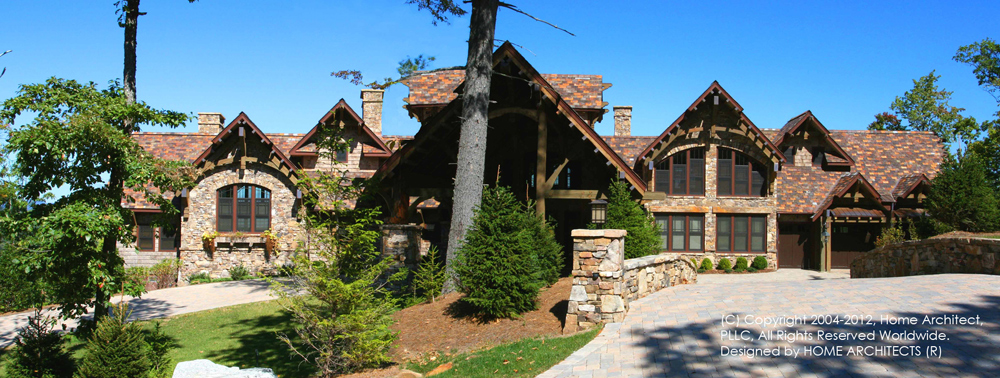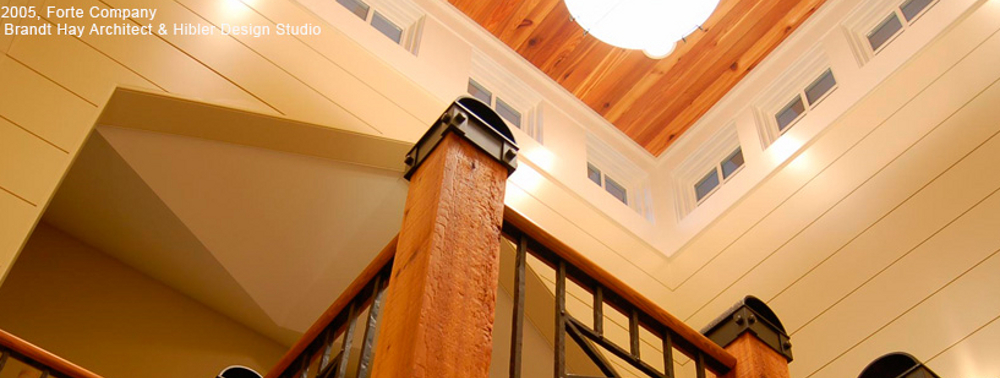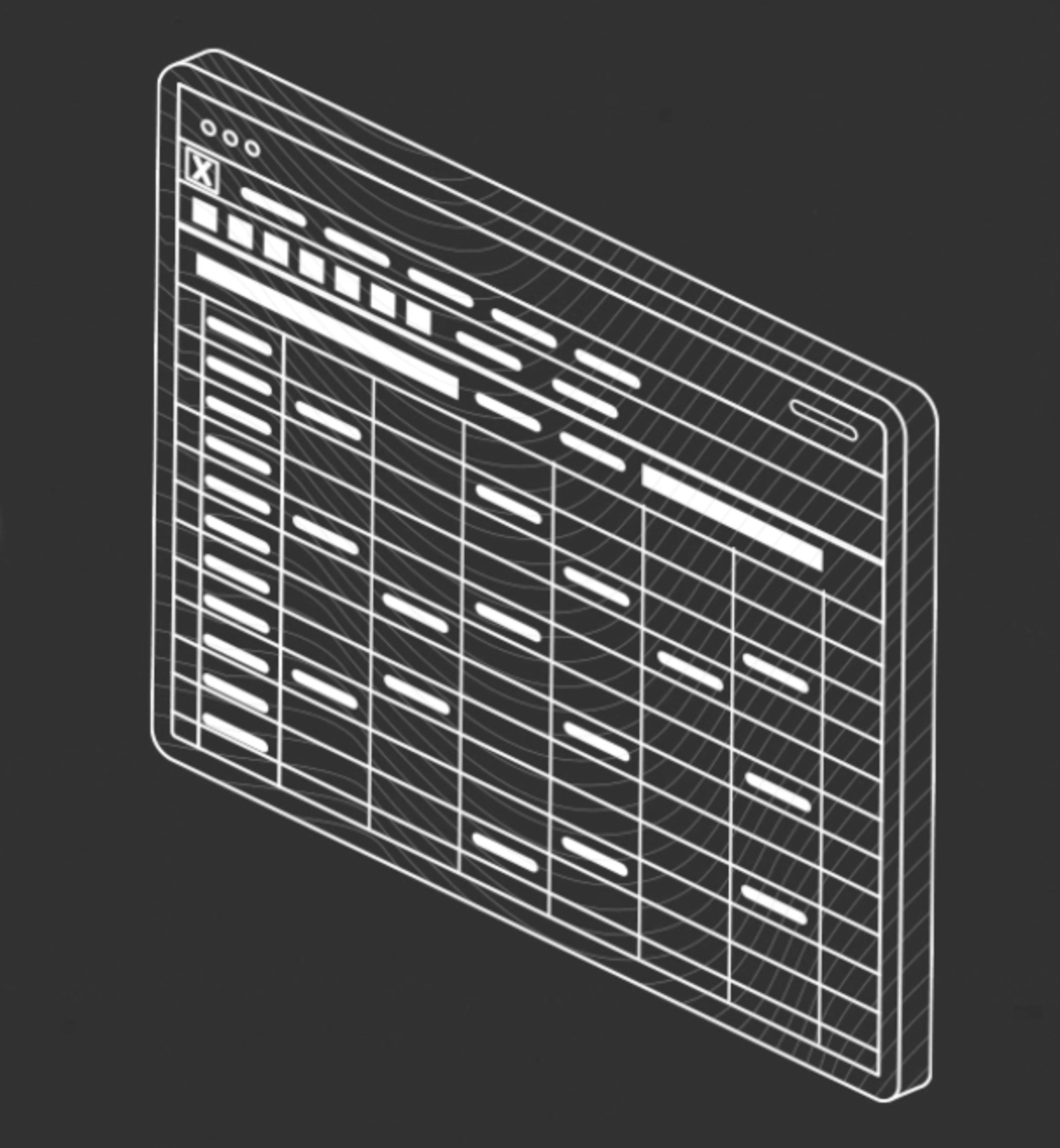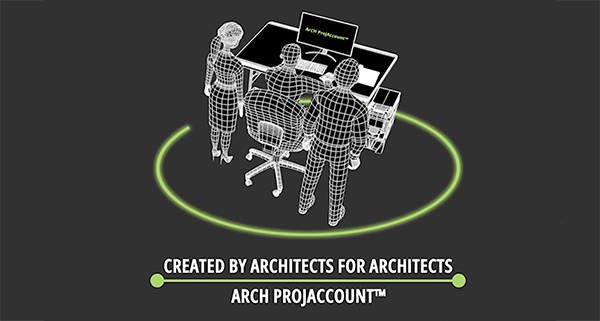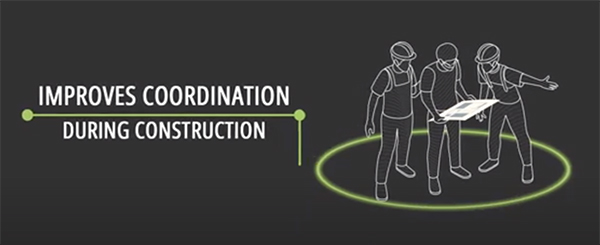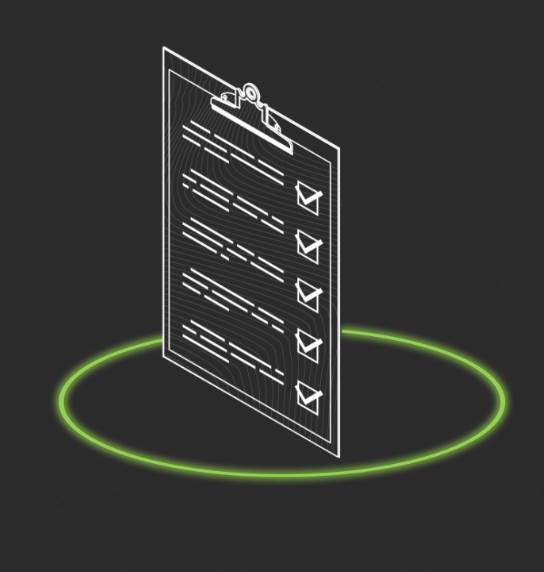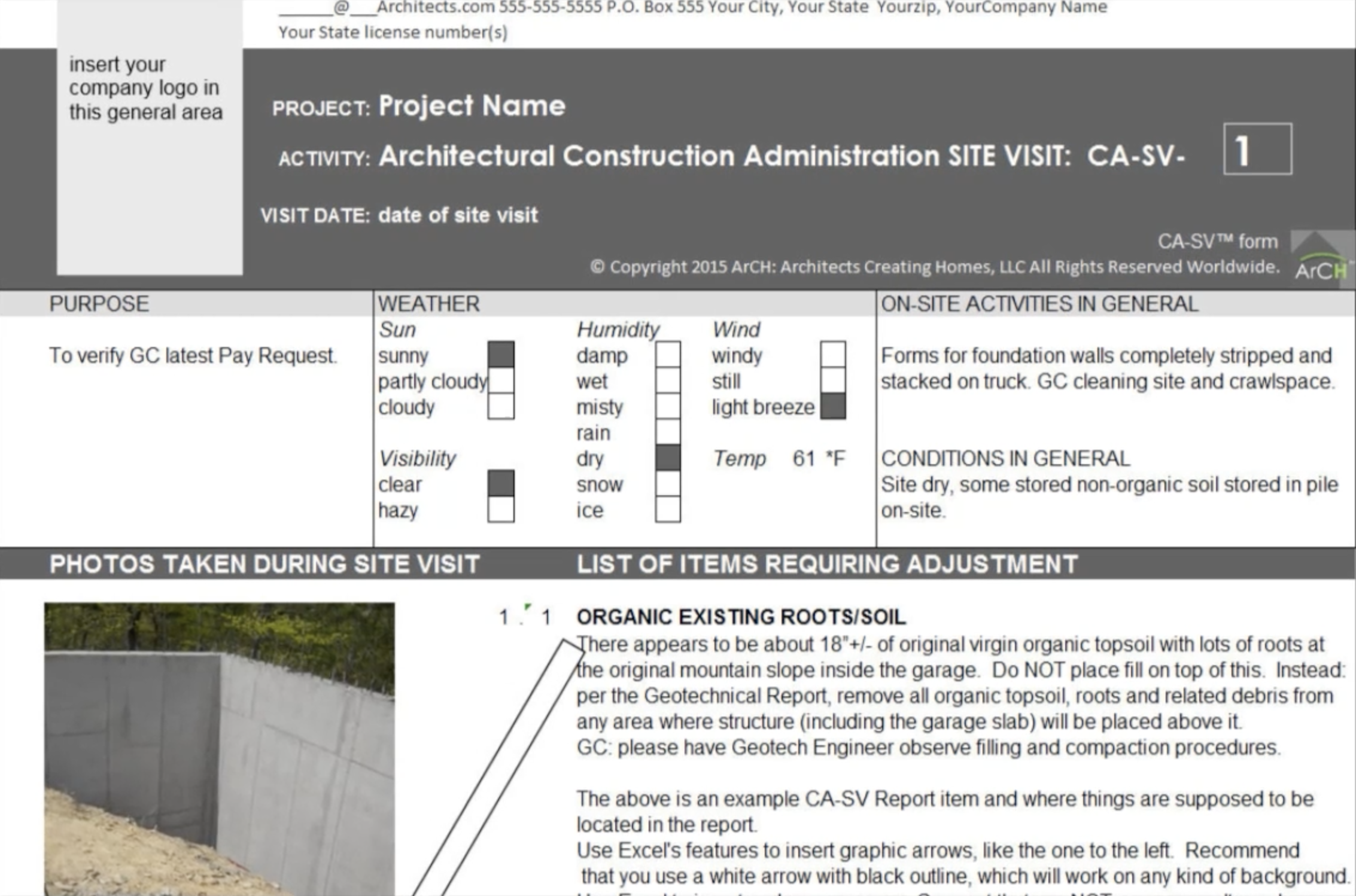The 2014 ArCH Residential Architecture Standards of Care (ArCH-RASoC2014) are as follows:
These SoC (Standards of Care) can possibly be used as a reference for various people, Architects, companies, or organizations. This could possibly be used to establish a particular level of Voluntary performance for architectural services on residential projects throughout the USA & world. ArCH is Not indicating that this is necessarily appropriate for all projects or for any project. This is the only National & Global Standard for Licensed Architects designing homes, to ArCH’s knowledge. ArCH has created this standard, because, to their knowledge, ArCH is the only independent professional organization in the United States & world that represents the interests of licensed Architects practicing residential architecture and whose mission is to improve residential architecture. In referring to this voluntary standard, it is suggested that you refer to this as the: “ArCH-RASoC: Residential Architecture Standards of Care, 2014 edition, found online at:
https://www.archomes.org/arch-rasoc2014
EDITIONS OF THESE SoC: These SoC may be updated from time to time. However, each updated version will have a new page, with the previous, earlier version left remaining, to serve as a guideline for anyone or any firm(s) or organizations referencing any particular year of this standard. Each new version will have a new page and a new URL. The intent will be to preserve the previous editions, so that any documents referring to them will continue to have that reference.
100. OVERALL
Architects will endeavor to create homes of functional beauty that respect the Health, Safety & Welfare of the Architect’s Client(s), the public and the environment. Architects will utilize their skills to create the best project of which they are capable, faithfully & honestly providing quality services. Architects will not be biased in their usage of materials, products or systems in their designs and specifications and will not accept compensation from material and/or system manufacturers or suppliers for using any particular products in any specific project, but rather, will exercise their best professional judgement in making decisions about what to include in a project.
200. CODES
The ICC (International Code Congress has indicated to ArCH that the IRC and the IECC have been adopted in all 50 states of the USA. It is unknown as to what codes may or may not exist in other countries beyond the boundaries of the USA. Therefore, Architects shall design homes meeting at least the minimum functional requirements established in the latest applicable edition of the IRC (International Residential Code) and the IECC (International Energy Conservation Code) as adopted and amended by the various States & counties throughout the USA (or, if more strict than the adopted edition, the Architect may use a more current edition of either or both). In other countries, if no other codes exist (which should be followed by the Architects in that location), then as a minimum, the above codes shall be followed.
In the absence of any stated such editions or any local enforcement, the Architect shall adhere to an edition of the IRC & IECC, published within the last 6 calendar years, existing at the time the project programming is commenced. ArCH by no means endorses minimum Code as guaranteeing good design. The Architect shall include such requirements above and beyond Code that in his or her own good judgement will result in a better project in terms of durability, structural strength, better environmental performance and other ArCH Best Practices. Any Architect using a more current stricter Code, or higher standards in his or her own good judgement, will not be found to have violated this ArCH standard. Any Architect making a project stronger, more durable, more energy efficient, in essence “better” than required by minimum Code(s) shall not be found to have done anything wrong in the use of this Standard.
300. FUNCTION
Architects will respect their Client’s functional needs and wishes in the design of the homes they create for them, to the extent that such needs and wishes are in the Client’s best interests and that adheres to Item 1 & 2.
400. BEAUTY
is in the eye of the beholder. However, there is something that holds a work of architecture together. Licensed Architects understand this and provide this. Good and great residential architecture coordinates with the Clients’ functional needs and their land to result in the creation of architecture that works well with both. However, no one will use this section as a basis of complaint if their vision does not match that of the Architect’s in terms of being or not being in compliance with this ArCH-RASoC.
250. PHASES OF WORK
Architectural firms can vary considerably regarding what work they accomplish during what work phases and what they may choose to call these work phases. Much depends on the type of project and the nature of the work undertaken. For instance, one project may primarily involve Programming and Master Planning large acreage for future development. Another project may be a very small, one-room addition or limited renovation in a Kitchen. However, for many projects providing “normal” services, such the design of a new home of average (1,200 HSF to 2,500 HSF) (Heated Square Feet) to larger size, many Architects are trained to generally follow these phases of work for “conventional” projects in which the Architect is engaged to provide these services: Programming, Schematic Design, Design Development, Construction Documents. However, the Architect’s scope of work can be more; it can be less, depending on the agreement between the Owner & Architect. It depends on what the Architect has been hired to do and what that Architect’s Basic Services and Additional Services are defined to be within each Architectural firm’s Owner-Architect Agreement Contract. So, understanding that there is no one-size-fits-all scope of services, the following could be interpreted as being a “typical” project, if all parties agreed to this Scope of Work:
——————————————————————————–
BASIC SERVICES: (P, SD, DD, CD)
PROGRAMMING (P)
SCHEMATIC DESIGN (SD)
DESIGN DEVELOPMENT (DD)
CONSTRUCTION DOCUMENTS (CD)
——————————————————————————–
ADDITIONAL SERVICES (all optional):
BIDDING (B) (Optional)
VALUE ENGINEERING (VE) (Optional)
CONSTRUCTION ADMINISTRATION (CA) (Optional)
ELECTRICAL SCHEMATICS (Elec) (Optional)
CABINETRY ELEVATIONS (Cab) (and possible related interior elevations) (Optional)
INTERIOR DESIGN (ID) (Optional)
3D IMAGERY (3D) (Optional)
RECORD DRAWINGS (RD) (Optional)
PROJECT MANAGEMENT (PM) (Optional)
OTHER SERVICES (as the parties may agreed to include)
——————————————————————————–
Some firms may choose to include some of the Basic Services listed above into the Additional Services, or they may choose to provide some of the Additional Services into their Basic Services. Or they may make no distinction between Basic and Optional services and simply work on various tasks as they proceed, with the acceptance of their clients, at each stage.
However, many architectural companies have been trained to separate Basic Services from Additional Services, and to indicate in their agreements what services are included in the Basic Services and what optional services are available in the Additional Services. Some firms mandate that their Basic Services must include at least those phases indicated above under Basic Services. Some firms may decide to include some of those indicated as Additional Services above into their Basic Services. For instance, some firms may mandate that they provide Bidding and Construction Administration for all of their projects. Although, not all firms will do so. It depends on each firm’s choice of practice and what their clientele agree to accept. Some other firms may include some 3D imagery into their Basic Services and charge accordingly for that.
Not many firms include As-Builts as part of their Basic Services and virtually no firms will include more work into their Basic Services without appropriate compensation. If you happen to be a Client and are thinking: “Well, of course, Electrical Schematics should be included!” Most architectural firms would be happy to included this service, but if you imagine that this service will be provided for no additional cost, think again. You, in your business, deserve to be paid for what you do and what you provide. Architects mainly provide time and talent, whatever the mechanism of payment may be for your project. And when some service requires time and/or provides you with value, that service deserves to be compensated.
The services Architects provide is very technical. They spend decades in school, college and graduate school, being educated in architecture, then additional decades in gaining experience, becoming licensed and continuously taking update courses and creating architecture for their Clients. It is not easy and many of those who set out to become Architects do not succeed. Some ArCH members can remember that the dropout/flunk-out/career-change rate can be as high as 90% in some demanding colleges of architecture. So, if you are the Client of an Architect, know that you are obtaining services from some of the best, most intelligent and capable professionals in the United States. And they have to continue being all that, in order to remain Architects. Because they are licensed. In other words, don’t begrudge paying for the services you want. On the other hand, if you are an Architect providing services to a Client, it is part of your job to explain, especially in your agreement with your Client, what services you are providing and even to possibly indicate what services you are not providing, to help avoid questions and controversy later. To assist in clarifying this, both Clients and Architects may wish to consider using ArCHforms for their agreements, which is dove-tailed and connected by reference to this ArCH-RASoC standard.
Some people may want to know what might typically be expected to be included in each of the Project Phases indicated above. Once again, each firm’s practice can vary and there is no requirement that they must include all the items listed in this standard. Some firms may include more items that what is mentioned in this standard. It should not become an object of controversy or legal discussion if any particular firm’s agreement referencing this standard does to does not included all of the items discussed herein. It is not the intention of this ArCH-RASoC standard to mandate what each firm provides or does in any particular phase of work. Understanding that there can, will and are variances to the specific tasks and scopes of work in each phase, ArCH offers what could possibly be understood to be an “average” (although not mandated requirement) list of possible activities that some or many firms might possibly include in the various phases listed above:
PROGRAMMING (P)
This is usually where the Client talks and the Architect listens. The Architect takes notes and may make an occasional comment or ask a question once in a while. This is where the Client describes what they want the project to include. The Architect may have different means of documenting this information, such as an email that the Architect sends back and forth to the Client for verification of the Programmed items. Some firms may record such discussion(s). Often the Program becomes an electronic document of listed items, categorized into various sections, such as in the case for a home, listing the various rooms, sizes and features of the rooms and spaces inside and outside the house to become part of the project. For instance, one of the sections might list the Kitchen and under that heading, might be the type and size and general location of the anticipated appliances, sinks and general size and materials for that space. This would generally be continued, listing each anticipated Client lifestyle and possible room/space listing that helps to satisfy that requirement. There may be more information about proximities of some spaces to others, discussions of possible finishes, quality levels and other information. There may be a desired budget. However, the Architect is not responsible for what the Contractor decides to charge the Client to build their project. Architects are not professional cost estimators and are not Contractors and have no reliable method to guarantee any cost or range of costs. The Architect may want to go on record at least once, or possibly more often to mention to the Client when the Architect believes that a particular Client desire will increase the cost of the project. Many Clients appear to believe that whatever they desire will somehow be inserted into the project at no increased cost. This is Not the case and is Not aligned with reality. There appears to be a psychology, particularly with custom home design and construction that each Client believes that because of who they are or their “force of personality” that they will obtain the lowest prices (below market value) to build their house, while including everything they might imagine. This ArCH-RASoC standard is hereby stating that the Client is the entity responsible for the cost of their home project, not the Architect and not the Contractor. The Client is the one who wants certain features, sizes, materials, systems and who bought the land with characteristics that compel the Architect, Structural Engineer and Contractor to support the project on it, which can often consume Client resources to do so. The Architect, Engineer and Contractor typically have little to no involvement in the selection of the Client property and the cost of foundations (particularly on steep or otherwise challenged land) can significantly boost the cost of construction. It is normally assumed that the Architect use the established Program as the “bible” for the project and this Program becomes the reference manual for the design Architect to create the design of the project, in conjunction with information about the project site. The project site information can often be obtained from an in-person site visit for which the Client compensates the Architect to provide. Or, the Architect will often request that the Client’s Surveyor provide a survey, typically with topographic contours and other features, such as building setback lines, location of utilities (or required future utilities, such as wells, septic fields, power lines and other requirements). It is the responsibility of the Client and a requirement of this ArCH-RASoC standard that the Client does provide this survey, having the features and software type capability and other characteristics as stipulated by the Architect. The Architect is responsible for requesting this survey of the Client. The Client will allow the Architect to have conversations and provide written (often emailed) lists of requirements to the Surveyor and to not interfere between the communications between the Architect and the Surveyor so that the Architect can obtain the features on the Survey that he or she needs to properly perform their work. These days, paper is nearly dead. In other words, the Architect’s work and the Client’s Surveyor’s survey will normally be electronic. This standard allows for the Architect to mandate the version and type of software the Architect requires and uses in order for the Architect to conveniently perform their work.
SCHEMATIC DESIGN (SD)
Architects are typically trained to first program a project so that their early designs have meaningful solutions relevant to solving Client requirements and working with accurate site data. Therefore, the Architect will typically rely on the Program (See Programming above) to provide the information to allow him or her to create an early design that has useful features that have functional usefulness. Yes, there can certainly be a “search for the form” or the “big idea”, however, there should be a rational basis for any architecture, particularly for a custom home design. The program allows the Architect to have a method deemed: “Ready, Aim, Fire.” Once in while, some Clients may wish to ignore prudent, rational design phasing and “get right to the designing.” This is Not consistent with this ArCH-RASoC standard and is strongly Not recommended. That would result in a “Fire, Ready, Aim” method that will likely have unpredictable and probably non-functional solutions that don’t meet un-voiced requirements.
Therefore, the Program is a critical part of a rational design methodology. You need to understand what and why you are designing something before you begin to actually give it form.
Now then, the first step in SD (Schematic Design) is usually accomplished in what is called “plan view”, in other words, looking straight down. This often involves two main types of drawings:
Site Plans
Floor Plans
These two types of drawings work hand in hand. Why: you really can’t create a Floor Plan if you don’t know what the limitations, setbacks, utilities, easement and other features are crisscrossing a site. The land may look open and unencumbered. It is not. There is a cat’s cradle of utilities and other items, invisible, perhaps, to the naked eye, but nonetheless there, when you see a survey and a Site Plan. The Floor Plan(s) must begin with an understanding as to the limitations of the site. Otherwise, a corner of the house might be stepping on something, like into a building setback, or electrical power easement, or water body wetlands setback or septic repair area. The Architect must know where Not to place his building and house(s) as well as where to place them.
For this reason, some Architectural firms may choose to limit their SD work to just the Site Plan and Floor Plan. As mentioned earlier, it will be required of the Client to engage the Surveyor to provide the survey, on which the Architect will depend for his Site Plan, and therefore, the Floor Plans, which depend a great deal on the restrictions imposed by elements acting on the Survey, duly recorded by the Surveyor.
Some architectural firms may choose to provide more drawings and features into their SD phase work. This is a matter of preference. Those who only provide Floor Plans and Site Plan(s) are often acting prudently, as they are showing how the Client’s lifestyle is being arranged on the the land. This is a highly functional diagram that communicates to the Client how and where they will be moving through their future home. Everything else depends on these early plan-view documents. Some Architect feel that to do any more would take more time and effort and most Clients are eager to see the direction of the project, therefore, these are the “plans” that some Clients refer to in their quest for a design solution. While there is no requirement to provide anything more, some companies do so. This practice is neither mandated or restricted by this standard. It is up to each firm. Those who only provide the plan view documents may receive a swifter approval or request to alterations and then may be able to proceed more swiftly, but that is up to each company.
DESIGN DEVELOPMENT (DD)
Some architectural companies may include these features in this phase of work:
Front Elevation
Left Side Elevation
Right Side Elevation
Rear Elevation
Updated Site Plan(s) and updated Floor Plans
Other firms may choose to provide much more, such as some building sections and/or special area elevations, and Roof Plan(s), and/or 3D imagery (which many firms regard as optional).
Some firms may first provide a Front Elevation (the side of the home seen by the Client when approaching it from the road, street or driveway), and obtain an approval of this critical view of the home before proceeding. This approach allows the Architect to proceed with confidence, knowing that the Client is happy with the the design image of the project before proceeding to create all of the elevations. However, other firms may use special 3D software than compels them to create the entire shell of the home as they create the plan, and so, their design solutions may provide 3D imagery as a by-product of their design work, allowing them to present that at whatever stage they feel comfortable. Other firms may be working with 2D software and find that a careful approach that present one type of drawing to the Client in a controlled manner allows the Client to participate in the viewing, commenting, editing and approval process. It can become a process in large part suggested by the software used by the Architect and no one software or method is deemed “the correct” software or method.
Some firms may choose to provide other additional drawings and views of the project during DD. Other firms may believe that doing so is wasted effort, until the Client approves the main appearance and organization. Neither approach is necessarily better than the other, as long as the Architect does keep the project moving forward, presenting a logical sequence of drawings and imagery to the Client to result in a more detailed set of documents than existed in the previous phase. The Client has an obligation, as part of this standard to accept that what they approve today, includes all the previous work leading up to this point. No Client can go back and request changes to previously approved items, or items that impact the work being done today and expect that any changes made to those previous documents or solutions will be accomplished at no additional charge. Architect works in a generally logical, progressive manner, building on the work done previously, to continue adding to the detail and level of completeness of the solution for tomorrow. Everything is connected. The Architect needs to present the developing design work to the Client in a sequential manner, building on the previous work to accomplish the future work. The Client must review, request changes and approve this sequential series of presentations, in cooperation with the Architect to allow the Architect to have a logical, continuous workflow. otherwise, the Architect is entitled to additional compensation to change previously agreed-to items. And as far as this standard is concerned, the Client’s allowing the Architect to move forward, implies consent and approval of all previous items upon which the succeeding work depends. However, this standard is not a Contract, but rather a standard of performance and the Architect’s agreement with the Client should document such matters.
The main point: is that DD further defines the project, often including the exterior elevations of the project. There may also be more or less other drawings and imagery depending on the Architect. However, this approach does allow the Architect to sequentially advance the project, obtaining the Client’s input and consent in a logical manner.
CONSTRUCTION DOCUMENTS (CD)
This is the point where many Clients believe the Architect is about done. This is not a correct assumption. Actually, this is the point where the Architect’s work really moves into high gear. This is where the Architect now must take all previous work and add more detail and drawings to it to result in a biddable, buildable, permittable set of Construction Documents that the building department and the Contractor will be able to use to permit and build the project. The documents involved can vary considerably, from firm to firm. However, there are basics that must be covered to allow the Contractor to obtain the building permit (along with documents from some other parties), and the degree to which the Architect provide details, specifications, and drawings definition can bear directly on the success of the project. See Section 500 MINIMUM DOCUMENTATION further in this standard below.
——————————————————————————–
ADDITIONAL SERVICES
Some/many Architect often find that the services below are Additional to the Basic Services provided by the Architectural firm. The main reason: the Client needs the above Basic Services in order to obtain a building permit for the architectural portions of the work. Most of the Additional Services below, while highly desirable, are not required by most, if any building departments. Does this mean that if you are a Client that you don’t need any of the additional services. That’s like asking: “Would you like trouble?” If your answer is “No, of course, I don’t want any trouble,” then you ought to give serious consideration to the Additional Services listed below. Do you really think that building departments across this Country have procedures in place to protect and defend you and make sure that you get the project that you want? No. They are there mainly to try to keep the Contractors in their jurisdiction adhering to MINIMUM code requirements. Most building departments couldn’t care less what requirements are in your CDs (Construction Documents). All they care about is once in a while driving to your project site and conducting a 15 minute walk-through to see if the Electrician has adequate clearance in front of an electrical panel or that there is steel in the footings, along with other minimal code requirements. It is Not the County or City Building Official’s job to make sure that your house doesn’t leak or fall down in a stiff wind. All they typically are concerned about is the letter of the Code and those are minimums. It typically takes thousands of people dying and billions of dollars of property loss before building codes are upgraded. Codes are in constant change. Many Contractor associations fight certain upgrades to the code on a State political level, because they are concerned that such changes might make homes more expensive and therefore will possibly result in people not wanting to build if it costs more. Therefore, there is pressure being made onto Codes to Not advance too rapidly. Architect, on the other hand, want their buildings and homes to last and of course Contractors do as well. But Architects in particular are the ones who want better quality to minimize water intrusion and result in a healthier home and to better resist winds and be more environmentally efficient with higher insulation values. The point being: Minimum Code Does Not a Good House Make. Your Architect wants to do better. Without your Architect’s involvement, you are very likely going to lose many of the “little” things that will, by the end of the project, add up to significant losses in the quality of your home. So: it is highly recommended that you Do have your Architect provide these Additional Services. Do Not imagine that your local building department will insure that your home will be built as designed and specified. It will not. This is not their job. Once again: their job is to periodically check “Minimum Code”, not all the good features your Architect put into your CDs. See the various Additional Services below under the following categories. Look for (Optional) beside the heading for each service.
—————————————————————————————–
500. MINIMUM DOCUMENTATION
At a minimum, the documents required at the local County, City or Township Building Department (documents required only for architecture) is what the Architect must provide. However, the Architect is permitted to charge the Client(s) for everything he or she provides the Client(s). Therefore, it is acceptable that the Architect indicate that some of their Basic Services include certain architectural items and that there are Additional Services that include other work items, some of which may or may not be required by the local Building Department. The Architect needs to provide those minimum Building Department drawings for architecture, assuming that the Client has compensated the Architect to produce them. Each Architectural firm has different ways of accomplishing their work. No particular Architectural company is the “right” way or “best” way. Furthermore, there is no fixed precise list of drawings and documents that an Architect has to provide. Some firms may include extensive finish documents, including Ceiling Plans, while other firms handle such information with Finish Schedules. The intent is that: by whatever means, each firm needs to convey the basics indicated in this Standard.
The Architect is Not required to produce ALL of the documents and forms required to permit a residential project,but rather, only architectural documents. For instance: it is common practice that the GC’s (General Contractor) HVAC subcontractor provide the energy form(s) required. However, the Architect may offer that service for compensation, if the Architect possesses those skills and desires to make that service offered. Also: the Architect is not required to provide Structural Engineering. The Architect may, as is often the case, have the Client engage and pay separately for a licensed Structural Engineer to engineer the structural aspects of a residential project, with the Architect coordinating that work, with the Structural Engineer cooperating with the Architect to coordinate the architecture and the engineering. The Client must direct the Structural Engineer to cooperate and coordinate their work with the Architect, if the Client separately contracts for this service. The above also applies of other engineering and other services beyond the Architect’s scope of work.
Furthermore, it is Not common practice for a residential project permit to require HVAC drawings, plumbing, civil engineering, or electrical drawings. The Architect, if desired, can provide schematic drawings and documentation for such items if the Architect feels they have the proper background to provide such items, with the understanding that such documents are often schematic in nature and are not actually engineered. If the Client does not wish to compensate the Architect for such documents, then the Architect is under no requirement to produce them. The Architect may, at their discretion, suggest or require their Client(s) to provide such engineers or other consultants that the Architect feels is necessary to deal with each project’s situations.
Also, it is not required that the Architect produce cabinetry, Master Plans, phased work planning, interior designs, interior elevations, color selections, detailed finish selections, appliance selections and other similar items. The Architect may offer such work/design tasks, often as Additional Services for the Client’s consideration. However, if the Client does not wish to pay for such services, they are not required.
Documents that are typically found in a “Best Practices” set of residential architectural documents for a new, typical home design of perhaps 2,500 HSF (Heated Square Feet) +/-, may consist of the following minimum types of documents as the project Architect feels are applicable to each project (sheet numbering and specific sheets can and will vary between practitioners: not all firms will include all of these or may include more. These are meant to indicate what a very well documented project index might list, but is Not required for all projects):
GENERAL
G.1 Title Sheet (sometimes including any State-required project information forms, which also may be found, if required by the Building Department, on other sheets)
G.2 General Information (Drawing Index, ancillary descriptions of project organization)
G.3 Abbreviations, General Information, Site Location Map
Note: each firm has different ways and means of illustrating the above. Some firms might have all of these on one drawing sheet, or might even combine these with the SITEWORK section below onto one sheet. Other firms might choose to include an elevation or rendering of the project on the Title Sheet, or may wish to have secondary 3D images of the project on additional sheets (but these are not mandatory). These are complementary sheets and do not affect the overall integrity of the drawing package.
SITEWORK
A2.1 Overall Survey
A2.2 Intermediate Survey (if zooming in on a large tract of land)
A2.3 Detailed Survey (if required on a large piece of ground)
A2.4 Site Plan (often at 1/16″ = 1′-0″, but this can vary).
Note: the above list under SITEWORK could, on a simple, small project combine both the Overall Survey, Site Plan and General Information on one sheet. Or the Survey may not be included, although this is generally believed to be a Best Practice (assuming that the Client cooperates to provide this). The above indicates what might be the result if a large tract of land comprised of many acres were in the project and if the Architect were in a position to compel their access in an electronic survey. The Client needs to cooperate in this regard.
There should be some depiction showing where the building/improvement area is on the Client property and that any required Building Setbacks, Septic System Setbacks, Well Setbacks and other required setbacks have been provided for in the design, often with references to the AHJ (Authority Having Jurisdiction) that mandates such setbacks. In the absence of any locally required setbacks, there are IBC International Building Code setbacks relating to Building Types that need to be respected regarding distances from property lines that should be referenced, if the project is that close to property lines.
FLOOR PLANS
A3.1 1st Floor Plan (often at 1/4″=1′-0″, but could be at another scale or multiple scales).
A3.2 2nd Floor Plan ( ” ).
A3.B Basement Floor Plan ( ” ).
Note: the above list of floor plans can vary widely, depending on the project. For instance, there might be additional detail floor plans of special areas. There might be additional floor levels, or fewer floor levels. If a very large home, there could be several different scales of plans, perhaps illustrating the overall grand scheme, with separate wings at larger scales. This varies from project to project. There should be detailed dimensions indicating the length and widths of the various walls and other items on the sheets. There should be notes identifying the items, or providing a means of understanding typical types of items. There should be section and possibly elevation references and other detailed information, such as door type codes.
ROOF PLANS
A5.1 Roof Plan (often at 1/4″=1′-0″, however, could be smaller or larger).
Note: the size and complexity of the project can make this vary considerably. However, it is generally considered a “Best Practice” to include a roof plan.
ELEVATIONS
A6.1 Front Elevation (often at 1/4″=1′-0″, however, could be smaller or larger).
A6.2 Rear Elevation ( ” ).
A6.3 Left Elevation ( ” ).
A6.4 Right Elevation ( ” ).
Note: there may be additional detail elevations, if determined necessary or desirable by the Architect. And unless the project has a very unusual shape, normally 4 exterior elevations are required to properly illustrate it, unless some of the elevations are identical. Some firms may choose to put these all on one sheet, or on other quantities of drawing sheets. But the information content should show the main 4 sides of the house (assuming that is the number of sides). It is typically Not a requirement that every nook and cranny in the facade have its own elevation. This can be illustrated if desired by the Architect, but is not compelled by any standard.
BUILDING SECTIONS
Some firms provide these and others do not, opting to just show some minimal Wall Sections. In ArCH’s opinion, it is considered a Best Practice to include at least one Building Section for a residential project, however, there is no requirement to do so. If they are provided, and more than one was provided, they might appear similar to the following:
A7.1 Building Section (Front to Rear) Longitudinal (often at 1/4″=1′-0″, however, could be smaller or larger).
A7.2 Building Section (Left to Right) Transverse ( ” ).
And there could be more, or less, depending on what each Architect feels is appropriate to adequately illustrate each project).
WALL SECTIONS
Wall Sections are almost always required, often as a requirement of the local Building Department. In ArCH’s opinion at least 1 Wall Section is required for each project, where new wall construction is involved. Wall sections are typically to illustrate: insulation and the R-values thereof, connections to the floor, ceiling and roof structures, interior finishes, exterior sheathing, deck to house connections, flashings, cladding and similar items, such as doors and windows, unless those items are depicted elsewhere in the project documents. Understanding that the number and type of Wall Sections can vary widely, here is an example:
A8.1 Wall Sections – Front Porch Foyer, Front to Rear 3/4″=1′-0″ (scale can vary).
A8.2 Wall Sections – Rear Porch, Fireplace, Rear Window Wall (Front to Rear) (scale can vary).
A8.3 Wall Sections – Stair 1″=1′-0″ (scales can vary).
A8.9 Wall Sections – Rear Doors – Sill & Head Details (Front to Rear) 6″=1′-0″ (scales can vary).
Each Architect will make his or her own decisions about which areas to depict. Some of these may be on the same drawing sheet or not at all. It depends on each project.
SCHEDULES
These have nothing to do with time, but rather lists of characteristics, typically for doors and finishes.
A9.1 Door Schedule
A9.2 Finish Schedule
Some Architects may choose to indicate the finishes for the floors, walls and ceilings in another manner than using a schedule. Or they may put the Door Schedule and the Finish Schedule on the same sheet. Firms with more evolved systems will likely have a dedicated sheet for each, but there is no rule to follow in this regard. However, the ArCH Best Practices does indicate here that in some manner, the Architect shall define what the finishes are on the floors, walls and ceilings. This can be accomplished graphically or through notes or schedules.
The characteristics and appearance for the doors of the project also need to be indicated. Most architectural companies do this by means of the Door Schedule, but there can be variations. Information for doors should indicate their: height and width, graphic appearance and material. Some firms also indicate each door type’s door frame trim material and appearance. Door elevations are often illustrated at 1/4″=1′-0″. Where fire ratings or minimum thicknesses and items such as door closers are required, such as between a garage and adjacent connected living space, the Door Schedule (or other means of conveying this information) should indicate these requirements (because of the life safety issues where stipulated by Code).
Some Architects or Builders may use Window Schedules and if they wish to do so, they can. However, this particular practice can result in errors due to duplication of size information in different locations in the document set. Some Architects instead prefer to show the R.O. (Rough Opening) width on the floor plans (and also the desired window manufacturer’s rough height), and then also show the rough heights of the windows on the elevations. This may require a little more effort on the part of the builder to gather the information, but the chances of making an error, particularly in the space available for the window heights, is less, because of the context of the window opening being shown. Therefore, beams, duct chases, upper level windows and other obstructing elements are there, on the building elevations, clearly showing the room available for the windows.
INTERIOR ELEVATIONS and/or CABINETRY (Optional)
A11.1 Cabinetry-Kitchen Window Wall 1″=1′-0″
As mentioned above, Architects are Not required to design and draw cabinetry and other interior details for a residential project to obtain a building permit, unless there is some accessibility requirement compelling such detail. For typical SFR (Single Family Residential) projects, this is often an Additional Service which the Client can choose to pay the Architect to provide. This is highly desirable, because it depicts the arrangement of not only the cabinets, but also of the walls and often the electrical switch plates and outlets (if the Client also selected to have the Architect provide Electrical Schematics). But once again, this is Not part of the minimum RASoC. And if cabinetry drawings are provided, it is suggested that they be at a large, detailed scale, such as 1″=1′-0″, although, this is not a rule. When showing the detailed cabinet elevations, it is a good idea to also include, perhaps at the bottom of the sheet, a blow-up of the floor plan area where the cabinets are taken from, to allow any related details to be indicated. There may be no cabinetry drawing sheets, or 1 or many (13+). It all depends on the services for which the Client is paying.
DETAILS
This can be varied in how many details an Architect decides to include. There may be relatively few, or many. These may be included on other drawing sheets, or be on separate detail sheets. Scales for details can vary, but are often larger blow-ups showing close-up areas of plans or sections. The examples indicated here depict “Master Detail” drawing sheets, which works well, but by no means is a requirement:
A12.3d Garage Entry Sill 3″=1′-0″
A12.4d-1 Stone Cladding @ Stud & CMU Walls 3″=1′-0″
A12.6rail-1-b Guardrail Details 1-1/2″=1′-0″
A12.6post Wall Base, Wind Post, Shear Wall details 3″=1′-0″
A12.7c Flashing/Edge, Soffit & Upper Wall Details 3″=1′-0″
A12.8a Window Section & Wall Details 6″=1′-0″
A12.8b Window Details – Flashing Tape NTS
A12.8d4 Door Detail Thresholds 6″=1′-0″
NUMBERED DRAWING NOTES
Architectural firms have different methods of noting their drawings. However, this is the ArCH: Architects Creating Homes “ArCHnotes” System, which is strongly related to the ArCHspecNote System. It is NOT a requirement of this ArCH-RASoC that all Architects use this system. This is a voluntary organization system that ArCH offers, but does not require. That is a matter of choice by each Architectural firm creating each project.
This system uses the A14 series of sheets in a set, although, this could be any series that works for the Architectural firm involved. In this system the various notes referring to items on the drawings are listed on the 1, 2, 3 or more sheets of Numbered Drawing Notes, along with a number, to the top and left of each text note. The numbers used for these notes comply with the historic and time-honored 16 Division CSI (Construction Specification Institute) breakdown of construction systems and materials. There are now 50 divisions of CSI, but these can be difficult to remember, particularly for laborers and subcontractors on jobsites. Therefore, ArCH has chosen to continue using the easier to remember and more compact 16 Division CSI sections, however, ArCH has also added Division 0 for Scope of Work and Bid Forms, and Division 17 for Low Voltage Systems.
Note: ArCH member firms are welcome to customize this note system to use the 50 CSI divisions, or to invent and use whatever notation systems work for their practice.
With the ArCH system, the idea is that a numbered drawing note starts with a note prefix of 0 through 17, which will instantly inform the trade or General Contractor, that the note applies to a particular type of work. For instance, notes beginning with a “6” are in the CSI division “Wood & Plastics.” A Numbered Note beginning with a “16” is an Electrical note. A “3” note is a “Concrete” note. The suffix of each note is simply a sequential number to differentiate each note in each Divison from each other. Therefore, here are possibly a couple of Numbered Drawing Note sheets used in a set of Architect’s drawings:
A14.1 Numbered Drawing Notes
A14.2 Numbered Drawing Notes
RECORD DRAWINGS (RD) (Optional)
“Record Drawings” can be provided as an additional service from an Architect when the Client does not have existing documents depicting what has already been constructed. “Record Drawings” means that in general, the “Record Drawing” indicate approximately what was previously built. This is often the case, particularly in an older structure or home. Architects are allowed to rely on the accuracy of any documentation provided to them from the Client or other sources such as Surveys, building departments or other providers. Architects do not typically represent that any partial field measuring that they provide to create “Record Drawings” will be precise. Architects have limited means of field measuring, and typically are Not equipped with 3D laser scanning or other expensive high-technology means, nor do Clients usually want to pay for such more expensive means, even if available. Therefore, Architects usually use simple, low-technology methods, such as using a tape measure to gauge the distance between two points. Since the Architect cannot get inside the wall framing or structure in a convenient manner to see and measure from the structural aspects, there is inherent guesswork involved as to how thick the walls are, where the structural walls, floors, roofs, foundations, framing and other items of the existing facility may be located. Also, there are limitations as to the accuracy of tape measures: the tape line sags, or may be partially bent around obstructions. The Architect may be forced to measure from a piece of trim on an outside or inside wall and the distance of the particular piece of trim to the structural wall, floor, roof and other elements can and will vary. It is also difficult to measure heights or roof slopes with any degree of precision, nor do Client typically wish to pay for anything more precise. Therefore, it is often noted on the Architect’s Record Drawings and other work upon which they are based that the Record Drawings are not perfect and that the Contractor will need to field verify all dimensions, conditions and locations and to field adjust proposed improvements based on actual field conditions. There is no particular percentage of accuracy applied to the creation of Record Drawings in this ArCH-RASoC standard and in fact, the Record Drawings are exempt from the degree of accuracy stipulated elsewhere in this Standard. Record Drawings documentation is typically Not the primary service for which the Architect has been engaged, but rather is an ancillary service of convenience for the Client, when the Client does not have other means of documenting existing conditions.
SPECIFICATIONS (Specs)
There can be controversy about whether to provide full specifications for a residential project. Some firms mandate that any project without specifications is like opening up a project to all sorts of potentially damaging possibilities, which can be true. Specifications set forth the quality, type, manufacturer and in some instances, location and manner of installation of materials and systems used in the project. It is considered one of the ArCH Best Practices to always include specifications for most residential projects, in one form or another. However, for very limited scopes of work, some Architects will only use enough detailed notes to provide adequate information to specify the limited items included in that specific project, without employing a full set of specifications. Such may be the case with very small renovations and additions. However, if an Architect is designing a new home of over 1,000 HSF (Heated Square Feet) (or sometimes smaller) it is highly recommended that a full set of specifications be used. This can make the difference between questions and omissions that can make a Client’s project have problems or provide the bedrock on which the project is based. While not always mandatory, specifications are highly recommended. ArCH understands that some firms might choose to create Specification Manuals (Books). However, ArCH’s experience is that somehow, such documents separate from the drawing set, often don’t make it to the jobsite, or even to the various subcontractors and the question can be raised: “What specs?” Therefore, it is ArCH’s position that it is most prudent to have the specifications on drawing size sheets, as an integral part of the drawing sheet set, bound with the rest of the set. With this in mind, the specifications sheets might look something like this:
A15.1 Specifications part (Div. 0,1)
A15.2 Specifications part (Div. 1,2,3,4)
A15.3 Specifications part (Div. 4,5,6)
A15.4 Specifications part (Div. 6,7)
A15.5 Specifications part (Div. 7)
A15.6 Specifications part (Div. 7,8)
A15.7 Specifications part (Div. 8,9)
A15.8 Specifications part (Div. 10,11,12,15H)
A15.9 Specifications part (Div. 15H, 15P)
A15.10 Specifications part (Div. 16,17)
And ArCHspecNote System numbers the paragraphs in the Specifications. Usually in a dark brown color (which on black & white printers or plotters will print black), which will print brown on a color plotter. Not all Architectural firms will employ this numbering system. However, it is an additional aide to connecting the information in the specifications to the drawings. These paragraph numbers are unmistakeable: they have a 5-digit+/- prefix-3digit+/- suffix. These SpecNotes can be used throughout the project documents, including on the drawings to identify items and materials and objects on them. The fact that these SpecNotes refer to specific specification paragraphs means that these SpecNotes offer explicit information about what things are in the set of documents. This leaves few questions as to what is what in the documents. This is a high-level of coordination that underscores quality architectural work.
However use of this particular notation system is NOT deemed a requirement of adherence to this ArCH-RASoC. The Standard of Care only requires that the Architect use SOME method of defining the various items drawn and indicated on his or her sheets and that there is a logical means of understanding what items in the specifications apply to the drawings. This could simply be the use of terms, such as: “Horizontal Lap Siding” on the drawings, which would relate to that specification item. But those Architectural firms that use the ArCHSpecNotes will make the task of linking specifications and drawings easier (while not mandatory).
ELECTRICAL SCHEMATICS (E) (Optional)
EG.1 Electrical Legend
E3.1 Electrical 1st Floor Plan (1/4″=1′-0″)
E3.2 Electrical 2nd Floor Plan ( ” ).
As mentioned above, electrical schematics may or may not be offered or provided by the Architect. The above is merely one example of how this might appear. There is No requirement mandating that the Architect provide these. If the Architect does, ArCH suggest calling them Electrical Schematics and including a note that they depict Schematic arrangements and do not constitute engineering. It is a legitimate practice of Architects to include such minor items related and derivative of their work.
STRUCTURAL (S)
Some Architects perform their own structural work. There are construction Attorneys that might advise that they instead have the Client hire their own Structural Engineers, which the Architect then coordinates for them. ArCH tends to agree with the construction lawyers on this matter. The intention of such legal minds: if you don’t provide these services contractually through you, you are technically not responsible for the performance of such Client consultants. In other words, it is viewed as a less litigious practice to have the Structural Engineers handle the structural engineering, which you coordinate, but which you, as an Architect are not legally responsible for. And this utilizes professional minds to do what they are best at doing. It should also be mentioned here, that the Architect and the project Structural Engineer are neither responsible for the separate engineering accomplished by the General Contractor’s truss provider, who always provides their own, signed and sealed structural engineering for the project prefabricated trusses LVLs (Laminated Veneer Lumber) girders and other similar items. These are typically for prefabricated roof and floor trusses. What the project Structural Engineer typically provides is the engineering for the foundations, dimension lumber framing, details, specifications particular to their work, and review and coordination of all Architectural work having to do with specifications and connections and similar items that affect the structural stability. With the foregoing in mind, and understanding that the Architect is probably not the one providing these documents, the structural portion of the documents might look something like this:
S1.0 General Notes – Structural 3/4″=1′-0″
S1.1 Typical Details – Structural 3/4″=1′-0″
S1.2 Typical Details – Structural 3/4″=1′-0″
S2.1 Foundation Plan 1/4″=1′-0″
S2.2 1st Floor Framing Plan 1/4″=1′-0″
S2.3 2nd Floor Framing Plan 1/4″=1′-0″
S3.1 Sections & Details – Structural 3/4″=1′-0″
These were taken from a recent set of documents. Keep in mind that another project might have no separate structural documents, or more or less. It all depends on the Architect, complexity of the project and the Structural Engineer. In any event, the Architect should not be held responsible for the performance, acts and documents of the Structural Engineer. Although, there should be at least some basic level of coordination of the then known and received files/documents of the engineer(s) in the possession of Architect during the Architect’s review and coordination process.
600. QUANTITY OF SHEETS IN A SET, LEVEL OF DETAIL
This varies widely. Unlicensed people might have as few as 3 to 5 sheets in a set. However, this is an instance of getting what you’re paying for. The level of detail in such a set is minimal at best, with no licensure to support the quality and likely no legal responsibility. A quality oriented Architectural firm could have 70 sheets in a set of documents, or over 100 for their mid-range 2,500 HSF houses to 5,000+ HSF sizes. Some firms might have 15 to 40 sheets. Each firm has their own level of detail that they produce relative to the project scope. However, there are some Architects that refuse to do less than a top-notch set of documents no matter what their compensation. Ultimately, there is no right or wrong answer as to how many sheets should be in a set of documents, or how detailed it should be. That is up to the Architect. Suffice it to say that ALL conditions can never be completely detailed. It is just not possible: architecture is too complex. However, the ArCH-RASoC recommends that at least enough is shown and detailed so that similar conditions can be deduced by the Contractor, based on how it was solved elsewhere in the documents, illustrating similar or related circumstances. Some Contractors, the better ones, in ArCH’s opinion, are the Contractors that prefer more detailed documents, as those eliminate more questions. The less detailed and looser documents with fewer sheets and less specifications leave more questions, making things harder to accurately price and build. The ArCH-RASoC endorses more sheets with more details and more complete specifications, appropriate to the project. Skimpy sets of documents create problems. More detailed documents answer questions before they are asked. However, no Client should expect to get more than they are paying for (subject to each Architect’s decision making). And the number of sheets has much to do with what Additional Services the Client requested. For instance, in the cabinetry section above, there could be 13+ sheets at 1″=1′-0″ for a 2,500HSF house. That means that the set of documents grows by 13+ sheets. And the more complex the project (where conditions are different), there may be more Building Sections and more Wall Sections. It can vary a great deal.
700. THE VOLUNTARY 95% RESIDENTIAL ARCHITECTURE STANDARD of CARE
Nothing is perfect. And neither is any set of documents used to build anything anywhere, ever. ArCH-RASoC hereby indicates that each set of documents signed and sealed by an Architect for residential designs should be well-coordinated, but not necessarily perfect, because we are human, and nothing humans make is perfect. However, sufficient care should be used in the creation of the documents that it becomes apparent to the Contractor what needs to be done to properly build the project. ArCH-RASoC hereby establishes that 95% of the technical notes, dimensions, specifications, schedules, drawings and other technical parts of the Architectural project documents shall accurately depict the intended project requirements, if this percentage standard is accepted voluntarily by an Architectural firm designing a project, as the standard of care decided to be adopted for the architectural work for a project. The remaining 5% of technical items, while possibly erroneous, and while not condoned, may be impossible to achieve. However, this is the limit on errors and omissions established in this particular ArCH standard. For a standard to have any realistic level of care, particularly if used as a referenced standard, it must be quantifiable, therefore this is the level of this particular standard. This standard of care will require vigilance on the part of the Architect and the other Client Consultants. The Architect will not be held responsible for errors, omissions and lack of coordination in the work of Client’s consultants and other project consultants, nor for lack of perfection and coordination of project elements not part of the technical requirements, such as, but not limited to abbreviation lists, lists of drawings, site location maps, surveys, precision of As-Built drawings, sheet names, renderings and other 3D graphics, and possibly other non-technical items. This does not mean that the Architect and other consultants are excused from coordinating their work with each other. That is a project requirement as part of these standards, however, changes made to the other consultant’s work without the Architect’s knowledge, cannot be held against the Architect’s performance, nor is the Architect responsible for work not his or her own.
800. DOCUMENTS PROVIDED, 3RD PARTY ARCHITECT
While the precise list of documents provided above is not specifically required in this ArCH Standard of Care, in general, the types of documents indicated are to be used where the project Architect feels these are required to properly document a project. If another 3rd party prudent & impartial Architect licensed in the declared venue of the project (which is not necessarily the same as the physical location of the project) would indicate that certain documents should have been provided, but were not, and that this resulted in errors & omissions exceeding the limitations established in this standard, this could be a basis of some discussion. Such 3rd party Architect will provide such documentation required in accordance with supporting information required by any agreements between any parties to document such reasonable and impartial opinions, relevant to this Standard of Care. Under no circumstances will this ArCH-RASoC be used to indicate that any Architect providing more documentation than perhaps another Architect might have provided, will be used to find any wrongdoing on the part of the project Architect. Nor will the Architect of Record be compelled to provide more documents than he or she agreed to do for the agreed-to compensation between the Architect and Owner. However, in general, the message of this Standard of Care is always that more documentation is better, rather then the opposite. Such 3rd party Architect may also refer to this complete ArCH-RASoC involving all numbered sections, taking in consideration that many sections are not compulsory.
900. BIDDING (B) (Optional)
If the Architect is engaged to provide this service (in writing and as defined by the Architect), this will include (under this ArCH-RASoC), the solicitation of licensed GCs (General Contractors) to bid this project. The Architect, under this SoC, cannot guarantee the performance of any bidding GCs, nor can the Architect insure that any GCs will be available or be interested in bidding the project. The Architect can research and seek interested bidding GCs, but has no means to compel any Contractors to do anything. Therefore, the Architect, under this SoC, cannot be found liable or responsible if bidders are not found and if they do not wish to bid the project. The Architect, may, at his/her sole discretion, under this SoC, seek a wider market, farther from the project, in an effort to find interested licensed GCs. ArCH has found that in some rural areas, at some distance from more metro locations, it may be more challenging for the Architect to find more experienced, technically-oriented licensed GCs willing and interested in bidding on more technical documents. Furthermore, there could be collusion in some smaller areas, against which, the Architect and Owner have no protection, other than seeking qualified GCs from a larger radius. Under this SoC, the Architect may seek from whatever distance from the project he/she deems required to find interested, qualified bidders. The Architect, under this SoC, is Not responsible for the cost of construction, nor for obtaining bids within any Owner-desired budgetary amounts. Architects are not professional cost estimators and are not the parties agreeing to build the project for a set amount: that would be the Contractor. The Architect has no control over what the GC decides to charge to build the design that the Owner had the Architect create for them. It is highly recommended that the Architect Not stipulate to any given desired Owner construction budget, as this is beyond the Architect’s control to guarantee.
During the course of the Bidding, this SoC suggests that the Architect consider sending an email to the bidders, listing the features, main materials and other reasons why this project should be able to be built for a reasonable price. This could help the Architect help the Owner to obtain more reasonable numbers from the bidding GCs, by pointing out the economical features and materials the Architect has incorporated into the project.
Should any bidding GCs have any questions of the Architect, the Architect will respond, within the scope of his agreed-to services for Bidding, to the GC asking the question. The Architect is hereby recommended to indicate in his/her Instructions to Contractors that each GC Not allow their subcontractors or material providers to directly contact the Architect at any time during bidding or during the construction. This is so the GC can control the flow of information for the project they are responsible to build. This SoC respects that obligation and seeks to reinforce the GCs position. It is recommended that all questions be in writing, typically in the form of an email.
ArCH has discovered, through the experiences of its members, that nearly 99% of all projects, particularly custom residential, will result in GC prices being More than the Client wishes to pay to build their dream home. This is quite normal and par for the course. There appears to be some basic psychological instinct in humans that makes us feel that because of who we are, or our force of personality or whatever, that we will obtain a lower price to build our dream house than what the going rate is. Reality conflicts with this when the bidding GCs provide their prices. This SoC recognizes this reality, which is one of the reasons why the Architect is Not held responsible for obtaining prices from GCs that reflect the Owner’s desired budget. Most Client budgets were not established from a thorough understanding or research of the detailed nature and costs associated with all of the features and materials that they want in their home, or that their building site demands, but rather, an arbitrary number that “sounds economical” to them. There is nothing (or should be nothing) in the Client-Architect Agreement that requires this.
GCs, may, after the bidding, suggest means to decrease the project cost by cheapening various materials or conditions. The Architect, under this SoC, is under no requirement to alter their documents to reflect such suggestions. If the Client wishes to compensate the Architect additional fees to consider and possibly make such alterations, the Architect can consider such situations, but is under no requirement, according to this SoC to make such changes, particularly if such changes are not deemed in what the Architect believes are the best interests of the Client, in terms of Health, Safety & Welfare, or in terms of damage to the design concept.
This SoC suggests that the Architect attempt to find 4 bidders for the project, if that is possible. The experience of ArCH members is that at least one of the bidders drops out (and there could be more). The hoped-for final result is 3 bids from licensed GCs. Some smaller, less sophisticated GCs can react negatively to quality, detailed, voluminous sets of CDs. The fact that the Architect has done a good job documenting the projecting means that whoever builds it should have fewer questions and know the prices more accurately, because more things are defined. The worst thing to come out of bidding a project with skimpy CDs would be for a GC to low bid it, get the job, then increase his/her profits by creating many change orders, to cover all the unknowns in the project. Such is the nature of the Construction World, more often than not. While a skimpy set of CDs might please the GCs, the Owner should be wary. More documents = more answers and less loopholes for the builders. Quality GCs should prefer better, more detailed CDs. Those are the builders that want to cooperate and build what your Architect has worked so hard to create for you. This SoC endorses and supports more detailed sets of CDs .
The Architect will, when obtaining the Bidders prices, induce them to use the Architect’s forms, so that the Bidder’s prices can be compared (“apples to apples”). The Architect cannot guarantee that the GCs will cooperate in this regard, but hopefully they will. The intention is that the Architect can then see the price breakdown for each bidder, comparing each builder to the other, seeing where they are high, low and normal. The Architect, under this SoC, will share his/her research of the bidders pricing with the Owner and discuss with the Owner what the various bids mean and what seems realistic and what does not. The Architect is Not compelled to recommend any particular GC to build the project and should in fact, beware of doing so. The Client should make the final decision, based on their own good judgement.
Under this SoC, typically about a month is provided for the Bidding time. Electronic documents and bid submittals are encouraged, as being faster and more efficient than paper. PDFs seem to work very well, in association with DropBox and other cloud server distribution reservoirs.
950. VALUE ENGINEERING (VE) (Optional)
Value Engineering almost always starts as soon as Contractors present their prices. This is normal. Because, it is very typical that the Contractor proposes a high higher than what the Owner wishes to pay. This is why VE exists. If you, as the Owner, can accept that this a normal part of the Project Flow, it will be easier to move through it. Despite the financial crisis that receiving a higher than hoped for price to build your home creates, yes, this happens to Most people, including billionaires, millionaires, professionals and plain working people. Why? Because everyone believes that they will be able to build their home for less than what they would like to pay, especially when special features are added. This belief appears to be nationwide and a psychological mindset that befalls nearly everyone contemplating having a custom home designed and built. Once again: despite how dramatic you might personally feel, this happens to almost everyone. We all want more house, with more features and higher quality than we are willing to pay for. Do NOT blame your Architect. He or she has faithfully designed the project you asked them to create, using good quality standards. You (the Owner) are responsible for the cost of your house. Why? Because you wanted it to be a certain size. You wanted certain features and materials and you approved the design and bidding/pricing phase. It is your house. The buck stops and starts with you. Accept responsibility as the individual who owns and began this project.
So, now that you, like just about everyone else in the USA, have received prices higher to build your dream home than you would have preferred and your blood pressure stabilizes, what to do? This is where you need to seriously consider paying your Architect an additional fee to have him or her negotiate and work together with yous selected possible Contractor to cut costs (called Value Engineering), while hopefully retaining the design intent and functionality of the project. You may feel that your Architect owes you this additional work because you somehow feel that it is their fault that the project came in over budget. No, it is not your Architect’s fault. And no, your Architect does not owe you more work to induce the Contractor to lower their price. These will be some of the most valuable Additional Services for which you pay your Architect to provide. They have a powerful position at this stage of the project and are uniquely well-qualified to work alongside the Contractor to brainstorm about what things to reduce in quality or eliminate or to postpone for a future construction effort (a future phase of work). It is the position of this ArCH-RASoC Standard (while not a requirement) that you sincerely consider engaging and paying your Architect to perform this highly valuable service for you. They are in a position to save the project and make it viable for you. This could be the positive “punchline” to this process to date and one of the most viable methods of lowering your project cost.
If it is any comfort to you, know that nearly everyone goes through this same uncomfortable situation. We all would like to have the Contractors build our dream homes for less than we want to pay and do it with a smile on their face. The reality: prices normally keep going up and the builder is under no duress to build your house for what lower amount you want to pay. They are in business to feed their families and support their employees and subcontractors, not give work or materials away for less than the going rate. So: realize that you will likely pay more, not less, than you imagined. Listen to your Architect when they tell you that you are asking them to do things that will increase your costs. And Architects: document, in emails, such notices to your Clients, so that if and when they question why didn’t you tell them things were going to cost more, that you have something to pull out and display that illustrates that you did, in fact, inform them. This standard has no requirement for such notices; it is just good practice.
1000. CONSTRUCTION ADMINISTRATION (CA) (Optional)
Construction Administration (CA) is typically an optional service, particularly for residential architectural projects. This standard makes No requirements on the part of the Architect to provide CA services. Make no mistake: CA services are Highly Recommended. However, Architects are Not obligated to provide them, particularly without additional compensation. It is the obligation of the Client (who likely is also the project Owner in a residential project) to request CA services of the Architect. If the Client Does request CA services from the Architect, this SoC suggests that the following minimum services be requested by the Client of the Architect:
.1 Periodic Site Observation Visits & Reports.
.2 GC (General Contractor) Pay Request Management
.3 GC Schedule of Values Review
.4 GC Substitution Request Review
.5 GC Product Submittal Review
.6 GC daily communications coordination & coordination with others
.7 Crisis Management
.8 Other CA activities that are agreed to between the parties.
.9 Closeout Document Review
.10 Substantial Completion Walk-through & Report
.11 Final Completion Walk-through & Report
The Architect will, if adhering to this standard, list the specific tasks and duties his agreed-to scope of CA will include (such as those above) and email this list of activities to the Client. The Client must agree to the Architect’s scope of CA services in writing (at least in the form of an email response to the Architect) in order for the Architect to be bound by them. Should the Client not wish to pay the Architect to perform any particular CA tasks (or for all of them), then the Architect is relieved of any obligations associated with such duties that he will Not be performing. The Client Not approving any of these tasks could introduce a disconnect into the process, making the Architect’s CA job more difficult, if not impossible to fulfill. If the full compliment of services above is Not implemented, then the Architect’s obligations to provide related services dependent on others can be nullified by this ArCH-RASoC standard.
In other words: if the Client approves the Architect to make 3 visits during the course of the construction, but not monthly, it will be highly likely that there will be many features and items that will be concealed by on-going construction, and the Architect will Not be able to see such concealed items and therefore will not be able to make comments about them, if they are in conformance or not with the final approved CDs. This makes the Architect not obligated to make any such comments about concealed items. Furthermore, the Architect is under no obligation to find each and every item in non-conformance with the CDs; the Architect’s visits are not considered to be exhaustive and likely no field measurements will be made by the Architect during such visits. Rather, the observation visits will be seeing what obvious conditions and items can be easily and conveniently seen: that is the nature of this particular service and this ArCH-RASoC standard. Nothing shall be implied in this standard to indicate that ALL non-conforming items will be entered into the Architect’s CA reports, only those that are obvious and easily observable from convenient observation from a walking position on the floor levels and around the site.
The Architect’s visits are Not to be construed by the Client as an insurance policy guaranteeing the work of the Contractor. Rather, the visits and reports of the Architect are guides and hedges that should help to guide the Contractor to correct obvious conditions, if the Architect is allowed and compensated by the Client to make such visits and reports in a timely schedule. Any free (gratis) CA visits on the part of the Architect will Not convey any responsibility on the part of the Architect whatsoever. Nothing will be construed as to make the Architect responsible in any way for the work of the Contractor. Only the Contractor is responsible for the construction. It is not the obligation of the Architect to “catch” each and every mistake or non-conforming item provided by the Contractor per this SoC.
PERIODIC SITE OBSERVATION VISITS & REPORTS:
If the Architect is engaged to provide this service (in writing and as defined by the Architect), this will include the Architect (and/or the Architect’s representative) coming to the job site (or visiting it electronically via digital photos and/or videos provided by others, as requested by the Architect) and observing various easily observable items and taking digital photos (if in person) and making notes. It is highly recommended that this frequency be at least once a month. The Architect and/or Architect’s representative will create a Site Observation Report for each site visit, in which he/she will include comments and matters of concern for attention on the part of the GC (General Contractor). If the Architect/representative is at the site in person, this report will include digital images of the various items being discussed. In particular, the Architect/representative will have comments about items that appear to not conform to the final approved CDs (Construction Documents) and approved modifications to the CDs. The intention is that the Owner-Contractor Contract will make reference to such Architect reports, with the requirement that the Contractor will be required to correct any such deviations prior to the next upcoming pay period (but this is a contractual matter that needs to be handled via the Owner-Contractor contract). It is the intent of the SoC that each such report of the Architect be an on-going “punchlist” that indicates items for correction by the GC.
These periodic visits should, in the best of situations, occur on a specific, regular schedule, such as once a month, just after the GC sends his monthly Pay Request to the Architect for the Architect’s review and certification. Because, the Architect will need to see the last month’s work of the Contractor in order to assess if the GC’s Pay Request is deemed to be appropriate. The Architect will email his/her Site Visit Report to the Owner and the Contractor, typically in a PDF form. The Owner-Contractor Contractor should require the Contractor to correct any items needing correction from a given report BEFORE the next month’s Pay Request.
PAY REQUEST MANAGEMENT:
If the Architect is engaged to provide this service (in writing and as defined by the Architect), this will include (under this ArCH-RASoC) the GC sending the monthly Pay Request to the Architect, for the Architect’s review, comments and certification, after the pay request has been adjusted to reflect what the Architect deems an appropriate amount for the work and items provided by the Contractor. Typically, this will require that the Architect/Representative will need to either in-person or electronically conduct a Site Observation (see above), to compare the work of the Contractor compared to the approved CDs (Construction Documents) and to the amount of such work being accomplished to date. This can entail reviewing the built work on the project site and possibly having the GC take the Architect to and display stored items purchased for the project. It is encouraged that the GC be required to store any such items, whenever possible, on the jobsite, under lock and key. If this is not possible due to the size of items or other features, the stored location should be within 10 miles of the project site, when possible. Further travel on the part of the Architect is not reasonable and should not be expected and is not part of this standard. The Architect may, as part of this standard, refuse payment for such GC stored items not on-site and not stored within 10 miles of the site. Any such stored items should be clearly labeled as belonging to this project and bundled so as to clearly identify such items and kept under lock and key. The Architect will Not (as part of this standard) be help responsible for the theft, damage or disappearance of any items approved for payment but not kept on the jobsite. It is strongly advised that Owners have their Attorneys include the provision of the 10-mile lock & key limit in their Owner-Contractor Agreement to assist the Architect in the performance of his duties and to avoid any controversy regarding such matters with the Contractor. It is recommended that such submittals be electronic.
Ideally, the GC’s Pay Requests will contain a percentage of consumption of each of the items on the Contractor’s Schedule of Values (see below). This will allow convenient understanding of what portions of the project are being built and incorporated and at what point of completion for each Pay Request.
SCHEDULE OF VALUES REVIEW:
If the Architect is engaged to provide this service (in writing and as defined by the Architect), the Architect, will, under this SoC, review the GC’s Schedule of Values. This means that the Owner-Contractor Agreement will need to require this Schedule from the Contractor. This will allow the Architect to review the amount of funds the GC will be expecting and billing for various parts of the work and compare this with the GC Pay Requests. It is recommended that such submittals be electronic.
GC SUBSTITUTION REQUEST REVIEW:
If the Architect is engaged to provide this service (in writing and as defined by the Architect), the Architect, will, under this SoC, review the GC’s substitution requests. The Architect is allowed to refuse to grant substitutions, as he/she deems appropriate to the project requirements. However, the Architect can compare the GC’s requests, comparing data the GC provides that allows the Architect to compare the manufacturer’s indicated product characteristics with those of the specified project item. It is necessary that the Client’s Attorney include language in the Owner-Contractor Agreement referencing this process to insure GC cooperation. It is recommended that such submittals be electronic PDFs, as much as possible.
GC PRODUCT SUBMITTAL REVIEW:
If the Architect is engaged to provide this service (in writing and as defined by the Architect), the Architect, will, under this SoC, review the GC’s product submittals. These may be in the form of shop drawings or manufacturer product characteristics and related items. The Architect will forward such submittals to other Client consultants, when such items concern the interests of another discipline and will obtain such reviewed documents back from the other Client consultants, add any Architectural comments and then forward back to the GC for their administrative action. It is necessary that the Client’s Attorney include language in the Owner-Contractor Agreement referencing this process to insure GC cooperation. It is recommended that such submittals be electronic PDFs, as much as possible.
GC DAILY COMMUNICATIONS COORDINATION & COORDINATION WITH OTHERS:
If the Architect is engaged to provide this service (in writing and as defined by the Architect), the Architect, will, under this SoC, receive and respond to GC questions and comments. The Architect may feel it necessary to also coordinate, at his/her sole discretion, with Structural Engineers, Geotechnical Engineers, the Owner, and others that the Architect deems appropriate to find answers to project questions. The Architect is specifically entitled to compensation for this service; this is Not considered a free service, or included with any other service.
CRISIS MANAGEMENT:
If the Architect is engaged to provide this service (in writing and as defined by the Architect), the Architect, will, under this SoC, assist the Owner in the resolution of critical events that may occur in the construction of the project. The Architect is specifically entitled to compensation for this service; this is Not considered a free service, or included with any other service. The immediate nature of such services does not render them free. Rather, the focus such events demand, will require payment from the Owner to the Architect to assist the Owner in solving such crisis issues. The Architect is Not responsible for such events occurring. The Contractor is solely responsible for construction and the events surrounding the Construction, as defined by this SoC.
OTHER CA ACTIVITIES THAT ARE AGREED TO BETWEEN THE PARTIES:
If the Architect is engaged to provide this service (in writing and as defined by the Architect), the Architect, will, under this SoC, assist the Owner with whatever activities the Owner & Architect agree to. These can be many and varied. For instance, the Owner may want the Architect to assist the Owner by helping them find and purchase appliances, furniture, colors, decorative treatments, submittal boards for HOA (Home Owner Association) reviews, and other activities that can be many and varied.
CLOSEOUT DOCUMENT REVIEW:
If the Architect is engaged to provide this service (in writing and as defined by the Architect), the Architect, will, under this SoC, assist the Owner by reviewing the GC’s Closeout Documents. It is highly recommend that the CloseOut Documents be electronic in the form of PDFs, wherever possible. Closeout Documents may vary according to each Architect’s practice, but often includes the GC’s filling out of product warrantee cards with the Owner’s contact information, product information manuals, product warrantees, maintenance instructions for various pieces of equipment and materials, and other information, usually of a technical nature for many items in the project. It is highly recommended that the Architect define the CloseOut Documents in their specifications for the project.
SUBSTANTIAL COMPLETION WALK-THROUGH & REPORT:
If the Architect is engaged to provide this service (in writing and as defined by the Architect), the Architect, will, under this SoC, appear at the jobsite (or provide his representative) to walk-through and around the the project, taking digital photos and making notes, especially focusing on creating a “PunchList” of items for correction by the GC. The intention is that this be the final punchlist, however, failure of the GC to correct each item, or the discovery of additional items prior to the Final Walk-Through may result in additional PunchList items being added to the initial Substantial Completion PunchList. The intention is that the GC will correct all the items on the Architect’s PunchList BEFORE the Final Walk-Through. The Attorney for the Owner should provide similar language in the Owner-Contractor Agreement to reflect this process to insure the cooperation of the GC.
FINAL COMPLETE WALK-THROUGH & REPORT:
If the Architect is engaged to provide this service (in writing and as defined by the Architect), the Architect, will, under this SoC, appear at the jobsite (or provide his representative) to walk-through and around the the project, taking digital photos and making notes, especially focusing on reviewing the previous Substantial PunchList (and any additions thereto), seeing if the GC has made the corrections to the various items on the list. If the GC has Not completed all of the items, or if additional items are discovered, the PunchList may shrink or grow. The hoped-for situation is that the punchlist will be totally complete and that no other items would be noted and that the project would be deemed completed by the Architect. The project may never be deemed totally completed by the Architect, if the GC does not cooperate and complete and correct all of the items on the final punchlist. There may be the creation/evolution of a Final PunchList. The Architect may or may not return to review those items, depending on the severity of such items and if the Client wishes to compensate the Architect for such return visit. The Architect is Not required to perform any return visits for no compensation. Ideally, the GC will complete all of the items, the Architect will see this status and will declare the project Final and complete. The Attorney for the Owner should provide similar language in the Owner-Contractor Agreement to reflect this process to insure the cooperation of the GC.
———————————————————————————————————
DISCLAIMER Note 1
Your reference to this standard in no way makes ArCH responsible for any controversy, legal actions, arbitration, mediation, dispute resolution or other actions established over using this standard. ArCH does not license Architects to obtain their professional licenses or to practice their profession, nor to police their activities. ArCH establishes certain requirements for its members who willingly adopt or ignore such requirements as they wish. The establishment of this Standard of Care is not a law or something that can be enforced. It is a level of care that various architectural practitioners or others may willingly decide to comply with in order to set the bar for their particular performance on certain projects, as they may wish. ArCH plays no part in such practitioner adoptions of performance, which is entirely voluntary of the part of any parties agreeing to such ArCH standards of performance. Any reference made by any parties to this Standard of Care is done with the tacit agreement that these ArCH copyrighted materials are being used by you as a licensee of this standard and in so doing you are agreeing to hold ArCH, its officers and members harmless and indemnify, defend and protect them in all respects (including any costs and reasonable Attorney’s fees) concerning your usage of said standards. ArCH hereby declares that any such standards are not necessarily declared appropriate for all circumstances and makes no claims as to fitness of purpose, merchantability or other usage for any applications which you decide to make by referencing any ArCH standards.
DISCLAIMER Note 2
How each architectural or other company or organization or entity chooses to reference this standard above is their free choice, and by using this standard you are agreeing that you are doing so without any legal requirements being encumbered onto ArCH, its members and officers. You are agreeing that you and others involved with your usage of such ArCH standards will not involve ArCH, its members or officers in any arbitration or legal proceedings referencing this standard or care, nor will ArCH submit to legal presence calling such as supoenas and the like. Should any entity attempt to violate this, they will become responsible for defending ArCH and it’s members and its officers, and paying for any costs associated with ArCH being required to explain this standard, including reasonable Attorney’s fees. ArCH is not stipulating to any particular architectural firm’s requirement to do anything in any particular manner. Rather, ArCH has set forth a Standard of Care that is a gauge against which anyone practicing architecture can be compared. What any entity decides to make of this comparison is their choice. Furthermore, ArCH is not insisting or requiring anyone or any organization or business or legal entity to use this above standard for anything. Usage of this standard is your choice, you are voluntarily choosing to reference this standard, much the same as if you decided to accept a particular ASTM standard for a particular product requirement or level of combustibility.

 <
<
